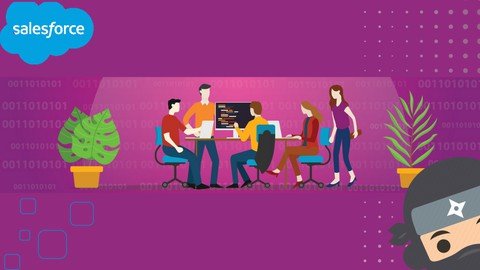Salesforce Admin'S Blueprint – Technical Design

Free Download Salesforce Admin'S Blueprint – Technical Design
Published 9/2023
MP4 | Video: h264, 1280x720 | Audio: AAC, 44.1 KHz
Language: English | Size: 124.98 MB | Duration: 0h 33m
Unlock the Power of Salesforce with Expert Technical Design Strategies
What you'll learn
How to break a requirement into sub tasks
How to identify which concept to use for given requirement
Identify and validate the best concept to complete the requirement.
Guided process to pick the right concept to complete the requirement.
Requirements
basics of Salesforce admin
Description
Are you a Salesforce admin?Do you get stuck when a requirement is given to you and you don't know how to proceed and implement the given requirement?Writing a technical design document for a Salesforce Admin involves documenting the technical aspects of configuring, customizing, and maintaining a Salesforce instance. This document is essential for planning, implementing, and managing Salesforce solutions effectively. Here's a step-by-step guide on how to create a technical design document for a Salesforce Admin:1. Document the Project Scope:Begin by defining the scope of your project. What specific Salesforce functionalities or enhancements are you planning to implement or modify? Clearly state the objectives and goals of your project.2. Identify Stakeholders:List all the stakeholders involved in the project. This may include business analysts, end-users, developers, and other relevant team members. Identify their roles and responsibilities.3. Define Business Requirements:Document the business requirements that Salesforce needs to address. Understand the pain points, challenges, and goals of the organization to ensure that your design aligns with these requirements.4. Document Current State:Describe the current state of the Salesforce instance. Include details about existing configurations, customizations, and data models. This provides a baseline for understanding what needs to be changed or enhanced.5. Proposed Solution:Present your proposed solution to address the business requirements. This may include:Configuration changes: Describe what Salesforce objects, fields, validation rules, workflow rules, and automation will be configured or modified.Customization: Explain if any custom code, such as Apex triggers or Lightning components, will be developed.Data Model: Outline any changes to the data model, including new objects or relationships.Integration: If the project involves integrating Salesforce with other systems, detail the integration approach.User Interface (UI): Describe any changes to the user interface, including page layouts and custom Lightning components.6. Data Migration Strategy:If data migration is required, outline the strategy for migrating data into the new Salesforce instance. Specify the data extraction, transformation, and loading (ETL) processes.7. Security and Access Control:Detail how security and access control will be managed in the Salesforce instance. Define roles, profiles, permission sets, and sharing settings as necessary.8. User Training and Adoption:Describe the plan for user training and adoption of the new Salesforce changes. This may include training materials, user documentation, and user acceptance testing (UAT) processes.9. Change Management:Discuss how changes to Salesforce will be managed over time. This includes release management, change control processes, and versioning of custom code.10. Testing Strategy: - Outline your testing strategy, including unit testing, integration testing, and user acceptance testing. Define test scenarios, test cases, and success criteria.11. Performance and Scalability: - Consider the performance and scalability of your solution. Discuss potential bottlenecks and how to address them.12. Deployment Plan: - Detail the deployment plan, including the schedule, rollout strategy, and rollback plan in case of issues.13. Documentation and Knowledge Transfer: - Specify how documentation will be maintained and how knowledge will be transferred to the admin team for ongoing management.14. Review and Approval: - Ensure that the document undergoes review and approval by all relevant stakeholders before implementation begins.15. Implementation Plan: - Create a high-level implementation plan that includes tasks, timelines, and responsible parties.16. Post-Implementation Support: - Discuss how post-implementation support will be provided, including monitoring, maintenance, and addressing any issues that arise after deployment.17. Appendices: - Include any additional documents, diagrams, or references that support your technical design.Remember that the technical design document should be a living document that evolves as the project progresses. Regularly update it to reflect any changes or new requirements that arise during the implementation phase. Effective communication and collaboration with stakeholders are crucial for the success of your Salesforce project.Regenerate
Overview
Section 1: Introduction
Lecture 1 Introduction
Section 2: Getting to know each other
Lecture 2 Getting to know each other
Section 3: Where am I struck?
Lecture 3 Where am I struck?
Section 4: Technical trouble
Lecture 4 Technical trouble
Section 5: Fight functionality fear
Lecture 5 Fight functionality fear
Section 6: Admin requirement breakdown
Lecture 6 intro
Section 7: Quick guide
Lecture 7 Admin requirement break down quick guide
Lecture 8 Full guide
Section 8: Thank you.
Lecture 9 Additional Resoureces
Beginners of Salesforce Admins
Homepage
https://www.udemy.com/course/salesforce-admins-blueprint-technical-design/Rapidgator
dkqob.Salesforce.AdminS.Blueprint.Technical.Design.rar.html
NitroFlare
dkqob.Salesforce.AdminS.Blueprint.Technical.Design.rar
Fikper
dkqob.Salesforce.AdminS.Blueprint.Technical.Design.rar.html
Salesforce Admin'S Blueprint – Technical Design Torrent Download , Salesforce Admin'S Blueprint – Technical Design Watch Free Online , Salesforce Admin'S Blueprint – Technical Design Download Online
In today's era of digital learning, access to high-quality educational resources has become more accessible than ever, with a plethora of platforms offering free download video courses in various disciplines. One of the most sought-after categories among learners is the skillshar free video editing course, which provides aspiring creators with the tools and techniques needed to master the art of video production. These courses cover everything from basic editing principles to advanced techniques, empowering individuals to unleash their creativity and produce professional-quality content.


Comments (0)
Users of Guests are not allowed to comment this publication.